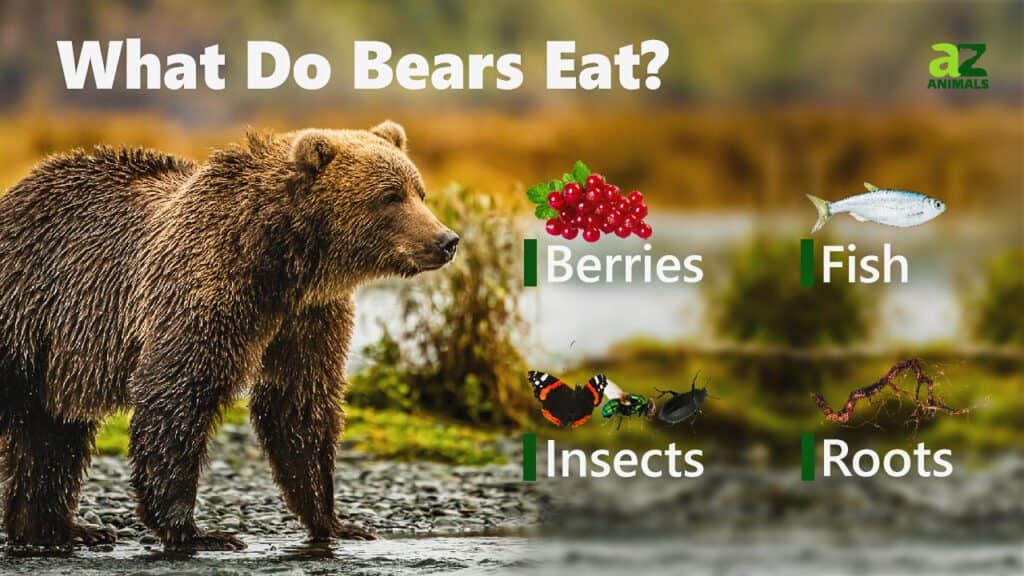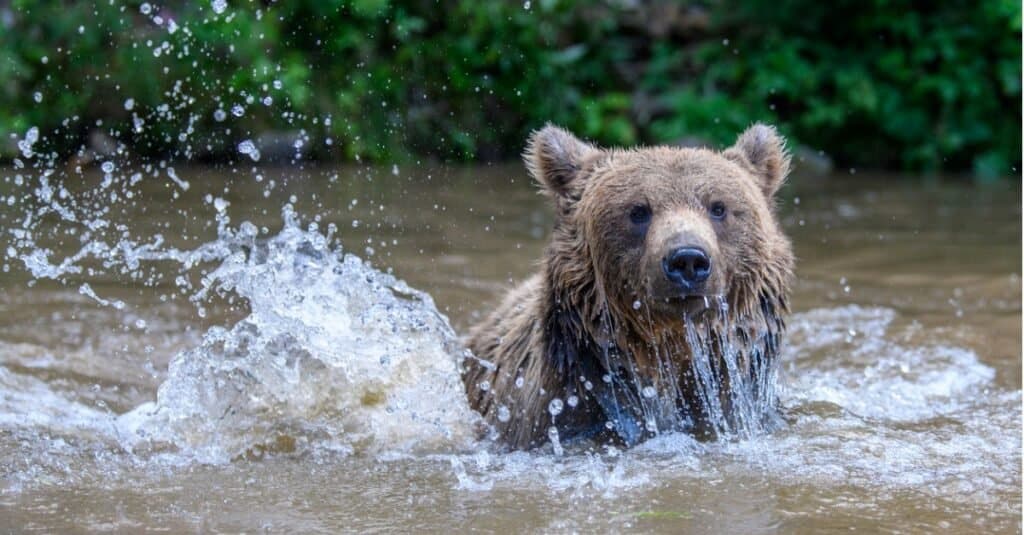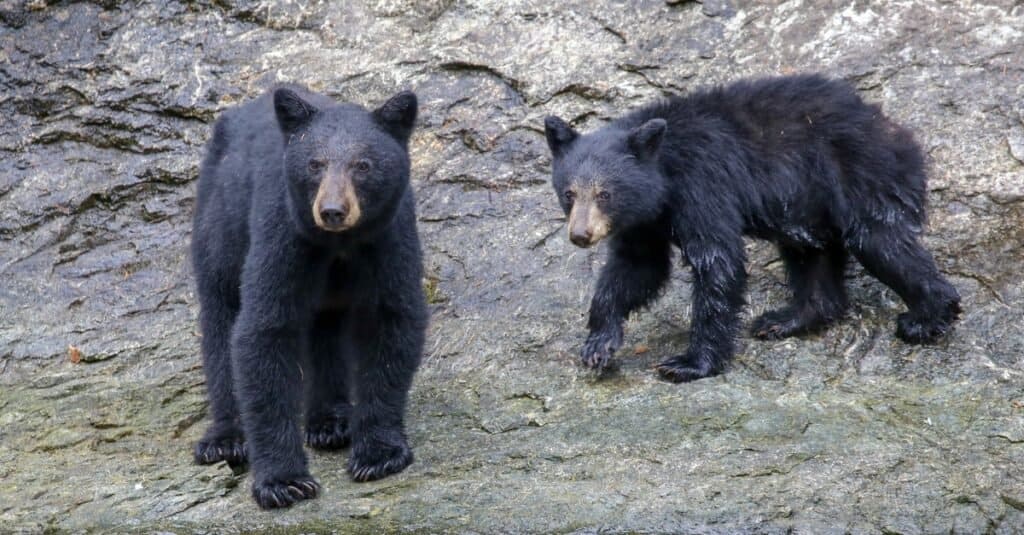Have you ever read Winnie the Pooh? Chances are you have, which means you know that there’s nothing Pooh loves more than honey. He eats the stuff by the bucket load and often thinks of little else except when he’ll get his next smackeral of honey. If your only exposure to bears was this children’s story, you’d be forgiven for thinking that bears only eat honey. In reality, Pooh’s depiction of bears’ eating habits couldn’t be further from the truth. Rather, the eight extant species of bear left in the world eat a wide variety of foods. These large land mammals forage and hunt throughout the Americas, Europe, and Asia, as well as the Arctic Circle. Although some species do eat rather specialized diets, no bear just sits around all day eating honey. Still, Winnie the Pooh’s depiction of bears begs the question, “what do bears eat?”
In this article, we’ll attempt to answer this question by examining the diets of bears. We’ll start off by discussing what foods most bears like to eat. We’ll then move on and explain how bears hunt and forage for food. Next, we’ll discuss what bears eat in the wild compared to what bears eat in captivity. Finally, we’ll end with an examination of what baby bears eat. So, get ready for a smackerel of knowledge, as we answer the question “what do bears eat?”
What Do Bears Like to Eat?

Bears are classified as carnivoran mammals, which means they’ve adapted to eat animal flesh. With their powerful jaws and bodies and long, nonretracticle claws, bears are one of nature’s greatest hunters. That said, most bear species are not predominantly carnivorous. In fact, the only true carnivorous bear species is the polar bear. The majority of bear species are actually omnivorous, meaning they eat a wide variety of foods. Additionally, there is one herbivorous bear species; the giant panda, which only eats plants. Given this variety in eating habits, it’s impossible to create a list of foods that all bears like to eat. Therefore, instead, we’ll simply focus on a list of 15 foods that bears like to eat, depending on the species. While not every bear eats all these foods, the list is still fairly comprehensive. 15 foods that bears like to eat include:
- Roots
- Vegetation
- Grasses
- Berries
- Fish
- Insects
- Larvae
- Honey
- Fruit
- Carrion
- Deer
- Seal
- Walrus
- Whale
- Bamboo
How Do Bears Hunt and Forage for Food?

Bears will often catch fish during salmon runs, as the fish provide an excellent source of fat and calories.
©iStock.com/Byrdyak
Every year, many bear species must put on massive amounts of weight in order to survive the winter. As such, bears must consume food almost nonstop from the time they wake up till when they go to bed. To help them in this task bears evolved excellent senses to aid them in their search for food. By far, sight, hearing, and smell are a bear’s most important senses. Evidence suggests that bears possess similar eyesight to humans, which helps them to spot edible plants and locate prey. Additionally, like dogs, bears can hear sounds within the high and low-frequency range exceptionally well. That said, a bear’s most valuable sense is its sense of smell. Scientists consider bear’s to have one of the best noses on Earth. Their sense of smell is around 2,100 times better than a human’s, and they can detect scents from miles away.
Depending on the species, bears rely on different tactics and strategies to find food. Overall, most bears are foragers, meaning they spend the majority of their time grazing for food. Many species of brown or black bear will devote hours to foraging for plants. Pandas take foraging to the extreme, spending 10 to 16 hours a day feeding on bamboo. Meanwhile, bears with access to freshwater will employ fishing tactics to catch salmon or other fish. To accomplish this feat, bears will often catch the fish with their mouths as they swim upstream. As for the polar bear, it relies mostly on ambush tactics to hunt seals. However, it will occasionally walk down and attack larger prey such as walrus head-on. Finally, when possible, bears will look for an easy meal by feeding on carrion or garbage. This can lead to issues when bears venture too close to human settlements.
What Do Bears Eat in the Wild?

Giant pandas eat exclusively bamboo.
©Hung Chung Chih/Shutterstock.com
In the wild, the foods that bears eat vary depending on the species, the season, and the environment. For example, giant pandas eat exclusively bamboo. On the other hand, polar bears eat mostly seals, as well as walrus and small whales. Meanwhile, vegetable matter makes up about 90% of the diets of most brown and black bears. In the spring, they’ll eat sedges, weeds, grasses, roots, and tubers. As summer arrives, bears will eat more fruits and berries as they begin to ripen. When available, they’ll dine on insects such as termites, beetles, or ants. If they can find it, bears will greedily suck down some honey including the honeycomb and any bee larvae they can find. Bears that live close to rivers may be able to fish for salmon as the fish migrate to their spawning grounds. Finally, bears will sometimes target young deer, or eat carrion
What Do Captive Bears Eat?

Most captive bears are given similar foods to what they eat in the wild, but their calories are closely monitored to make sure they don’t overeat.
©CSNafzger/Shutterstock.com
Bears that live in captivity are fed a varied diet to help them grow and maintain a healthy weight. Most captive bears’ diets vary from day to day and month to month as necessary. Many zoos will restrict bears’ calories to prevent them from gaining too much weight, as these bears don’t go through a period of hibernation and starvation. Common fruits include blueberries, raspberries, and strawberries. As for meat, many bears receive whole salmon, chicken, or rabbit. By consuming whole animals, captive bears get the benefit of eating the skin, heads, and organs, which are rich in fat and nutrients. They may also receive whole cow legs or deer legs, as the beers will chew the bones, which are rich in calcium. Additionally, many captive bears also receive vegetables such as squash, potatoes, and carrots, along with plenty of fruits like melons, apples, and grapes.
What Do Baby Bears Eat?

Bear cubs are completely reliant on their mothers for milk and protection when they’re born.
©iStock.com/Byrdyak
In the wild, baby bears are totally reliant on their mothers for survival. At birth, baby bears measure only around 1 to 2 pounds, depending on the species. They nurse in their den for 2 to 5 months until they emerge in spring. During that time, they subsist only on milk, which makes the bear one of the few animals that lactates extensively during hibernation. Once they emerge from the den, bear cubs still rely on milk, but also begin to eat other foods. The mother bear is responsible for finding food for her cubs and will feed them whatever she forages or catches. Cubs will stay with their mothers for up to several years until they’re large enough to venture out on their own. In captivity, baby bears subsist on milk replacement, and once they’re old enough eat a mush made of bear formula, puppy chow, and soft fruits.
The photo featured at the top of this post is © Volodymyr Burdiak/Shutterstock.com
Thank you for reading! Have some feedback for us? Contact the AZ Animals editorial team.






